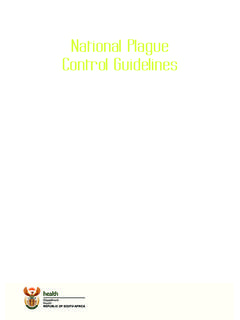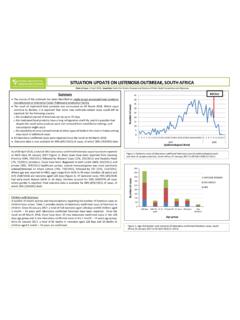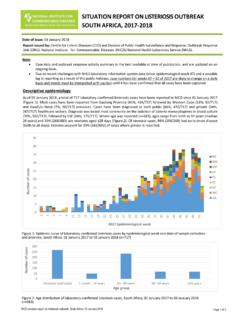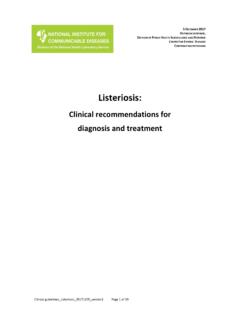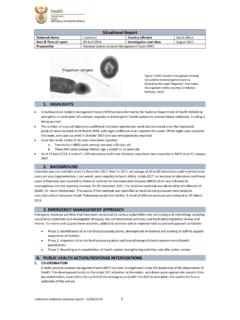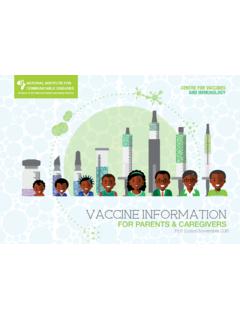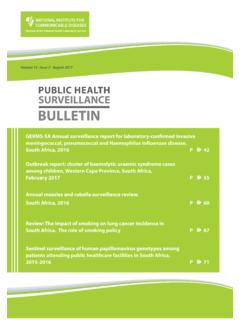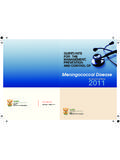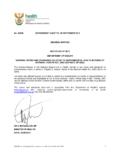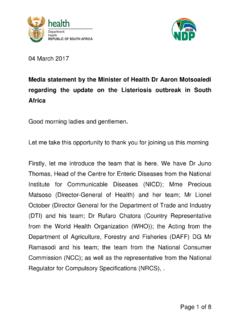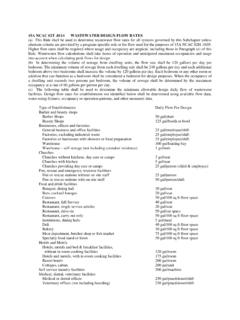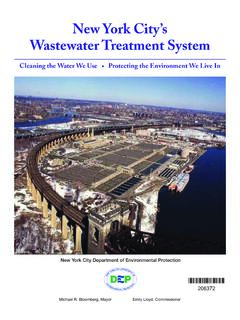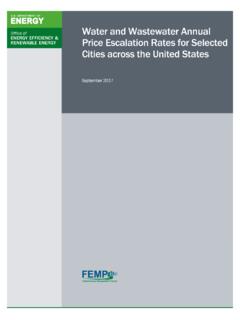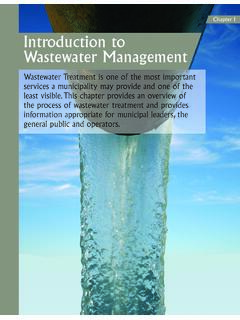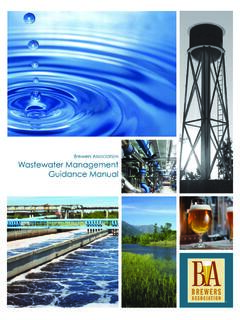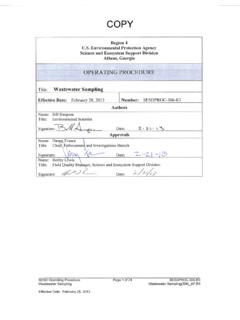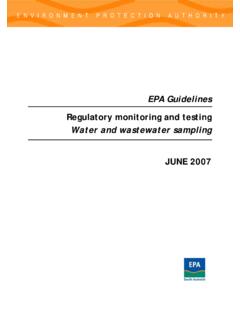Transcription of WASTEWATER-BASED EPIDEMIOLOGY FOR SARS-COV-2 …
1 WASTEWATER-BASED EPIDEMIOLOGY FOR SARS-COV-2 SURVEILLANCE IN SOUTH AFRICAWEEK 41 WASTEWATER-BASED EPIDEMIOLOGY FOR SARS-COV-2 SURVEILLANCE IN SOUTH AFRICAWEEK 46 OVERVIEWThis report summarises and interprets findings from detection and quantification of SARS-COV-2 levels by the NICD Centre for Vaccines and Immunology in influent (untreated) wastewater in 18 wastewater treatment plants (WWTP) across five provinces tested by the NICD, and 77 additional plants tested by SACCESS partners including the National Institute for Occupational Health, Lumegen Laboratories, GreenHill Laboratories and Praecautio to cover all provinces.
2 Levels of SARS-COV-2 in wastewater correlate with population levels of SARS-COV-2 over time and indicate the geographic distribution of disease. SARS-COV-2 is shed from symptomatic and asymptomatic persons in stool but is not transmitted by faecal-oral route nor via wastewater . This report is based on data collected from June 2020 up until the week ending 19 November 2021 (epidemiological week 46). Generally, levels of SARS-COV-2 are low and stable for decreasing across the country. Detailed analyses are described in figures and text levels of SARS-COV-2 are beginning to increase in some treatment plants especially in the Tshwane District Municipality and City of Johannesburg in Gauteng Province.
3 Increased clinical surveillance is needed in areas affected as well as a close monitoring of other plants across the country. Detailed analyses are described in figures and text belowHIGHLIGHTS Levels of SARS-COV-2 in wastewater in Gauteng, eThekwini and Cape Town, as well as certain other localised areas are increasing. The increase reflects increased population-level transmission and is likely to be followed by increased burden of cases and hospitalisations. Health authorities are requested to alert the public and promote vaccination and adherence to non-pharmaceutical interventions including mask wearing and social distancing.
4 Increases in the following areas have been observed: Gauteng Province Tshwane District Municipality: Four and three successive increases in SARS-COV-2 levels have been detected from Daspoort (Pretoria central) and Rooiwal (Pretoria North) WWTPs, respectively. Levels may be increasing in Baviaanspoort (Mamelodi). The City of Johannesburg: Three successive increases have been observed in Goudkoppies (Soweto). Levels may be increasing in Ennerdale (Johannesburg far south). Ekurhuleni: Two successive increases were detected in Hartebeesfontein (Tembisa) WWTP.
5 Levels may be increasing in Vlakplaats (Vosloorus and Katlehong) and JP Marais (Benoni) plants. Kwazulu-Natal: eThekwini: Two successive increases were detected Central WWTP (draining eThekwini central business district and the Bluff) Western Cape Levels at Zandvleit may be increasing additional samples will be required to confirm this. Northern Cape Levels in Calvinia appear to be increasing, but additional samples will be required to confirm this. SARS-COV-2 levels WWTPs from Nelson Mandela Metro and Buffalo City Metro in the Eastern Cape are low and stable.
6 No assessment can be made regarding current SARS-COV-2 levels in Mpumalanga, North West, Limpopo as recent specimens are not available. Testing frequency will be increased in these areas. PAGE 2 TOLL-FREE NUMBER 0800 029 999 PAGE EPIDEMIOLOGY FOR SARS-COV-2 SURVEILLANCE IN SOUTH AFRICAWEEK 46 Kerrigan McCarthy1,2, Said Rachida1, Mukhlid Yousif1,3, Nkosenhle Ndlovu1, Chinwe Iwu-Jaja 1, Wayne Howard1, Shelina Moonsamy1, Gina Pocock4, Leanne Coetzee4, Janet Mans5, Lisa Schaefer6, Wouter J. Le Roux6, Annancietar Gomba7, Don Jambo7, David Moriah de Villiers8, Nadine Lee Lepart8, Rabia Johnson9, Christo Muller9,10,11, Martie van der Walt12, Awelani Mutshembele12, Natacha Berkowitz13, Jay Bhagwan14, Melinda Suchard1,15 for the SACCESS network.
7 1. Centre for Vaccines and Immunology, NICD2. School of Public Health, University of the Witwatersrand, Johannesburg 3. Department of Virology, School of Pathology, University of the Witwatersrand, Johannesburg 4. Waterlab, (Pty) Ltd, Pretoria;5. Department of Medical Virology, University of Pretoria 6. Water Centre, Council for Scientific and Industrial Research (CSIR), Pretoria 7. National Institute for Occupational Health, a division of the National Health Laboratory Service, Johannesburg 8. Lumegen Laboratories, (Pty) Ltd, Potchefstroom 9.
8 Biomedical Research and Innovation Platform (BRIP), South African Medical Research Council, Durban10. Division of Medical Physiology, Faculty of Health Sciences, Stellenbosch University, Stellenbosch 11. Department of Biochemistry and Microbiology, University of Zululand, Richards Bay 12. Tuberculosis Platform, South African Medical Research Council, Pretoria. 13. City of Cape Town Health Department14. Water Research Commission, Pretoria 15. Department of Chemical Pathology, School of Pathology, University of the Witwatersrand, JohannesburgDETECTION AND QUANTITATION OF SARS-COV-2 AT SENTINEL wastewater TREATMENT SITES IN SOUTH AFRICAN URBAN AREAS, MARCH- OCTOBER 2021 CO-FUNDED BY THE WATER RESEARCH COMMISSION AND THE NICDBACKGROUND The detection and monitoring of SARS-COV-2 through wastewater was first proposed in April 2020.
9 Initial reports describing the feasibility and practical usefulness of this approach emerged simultaneously from several countries during August 2020. Recent evidence has shown that SARS-COV-2 can be detected in wastewater prior to the appearance of clinical cases, and longitudinal tracking of SARS-COV-2 viral load in wastewater correlates with the burden of clinically diagnosed cases. Sequencing of SARS-COV-2 RNA fragments in wastewater has identified variants of concern as well as mutations not detected in clinical cases.
10 In South Africa, SARS-COV-2 EPIDEMIOLOGY is monitored through laboratory testing of clinical cases using reverse-transcriptase polymerase chain reaction (RT-PCR) tests and rapid antigen tests, COVID-19 hospital admissions and COVID-19 - related deaths. Laboratory testing data is relayed by testing laboratories to the National Institute for Communicable Diseases (NICD) via the DATCOV system. From these data sources, PAGE 3 TOLL-FREE NUMBER 0800 029 999 PAGE EPIDEMIOLOGY FOR SARS-COV-2 SURVEILLANCE IN SOUTH AFRICAWEEK 46epidemiological indicators including incidence rates of testing and case detection, hospitalisation and death rates are made available to key stakeholders and the general public.
